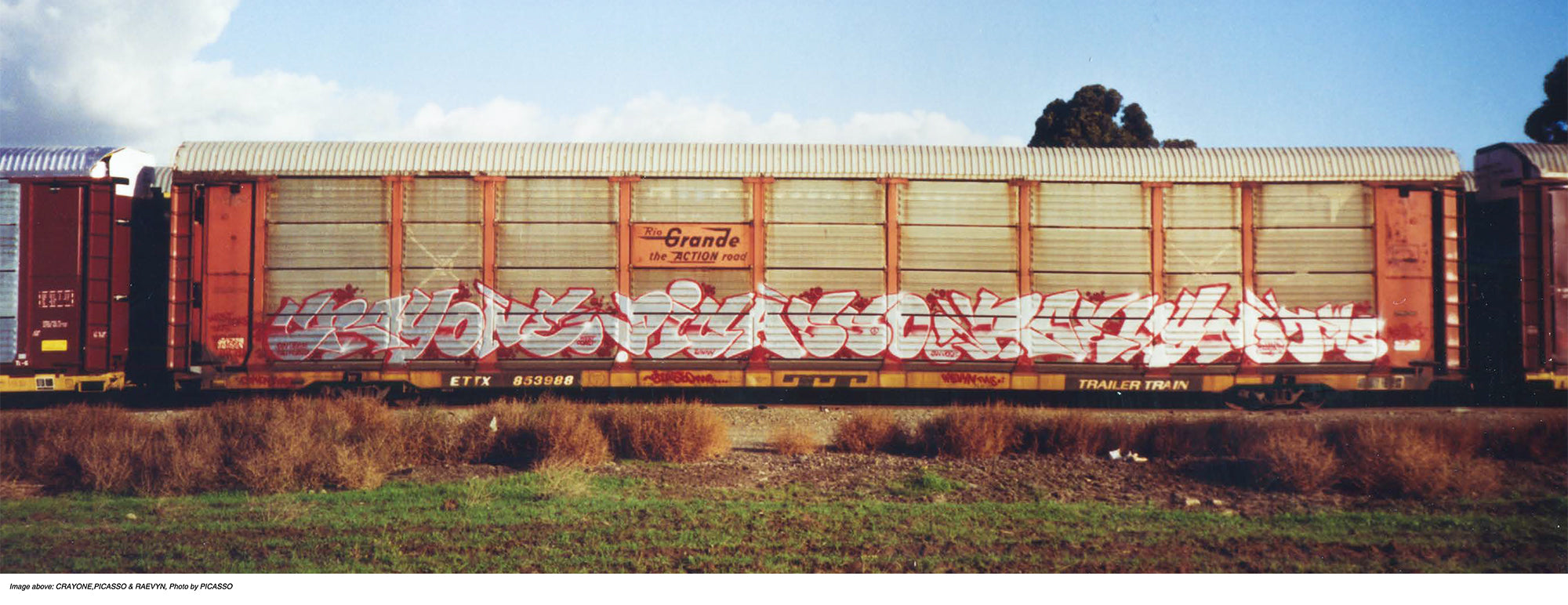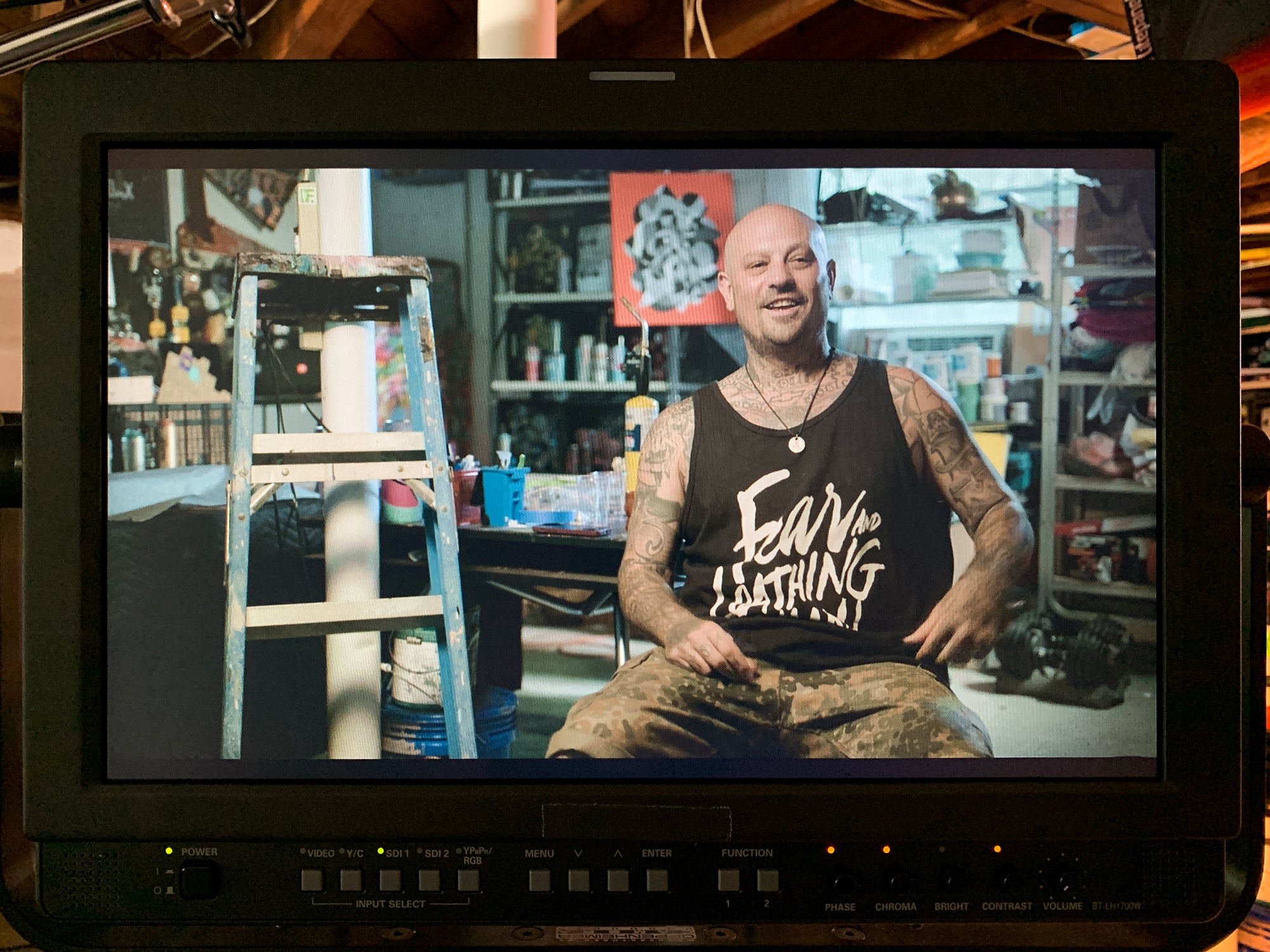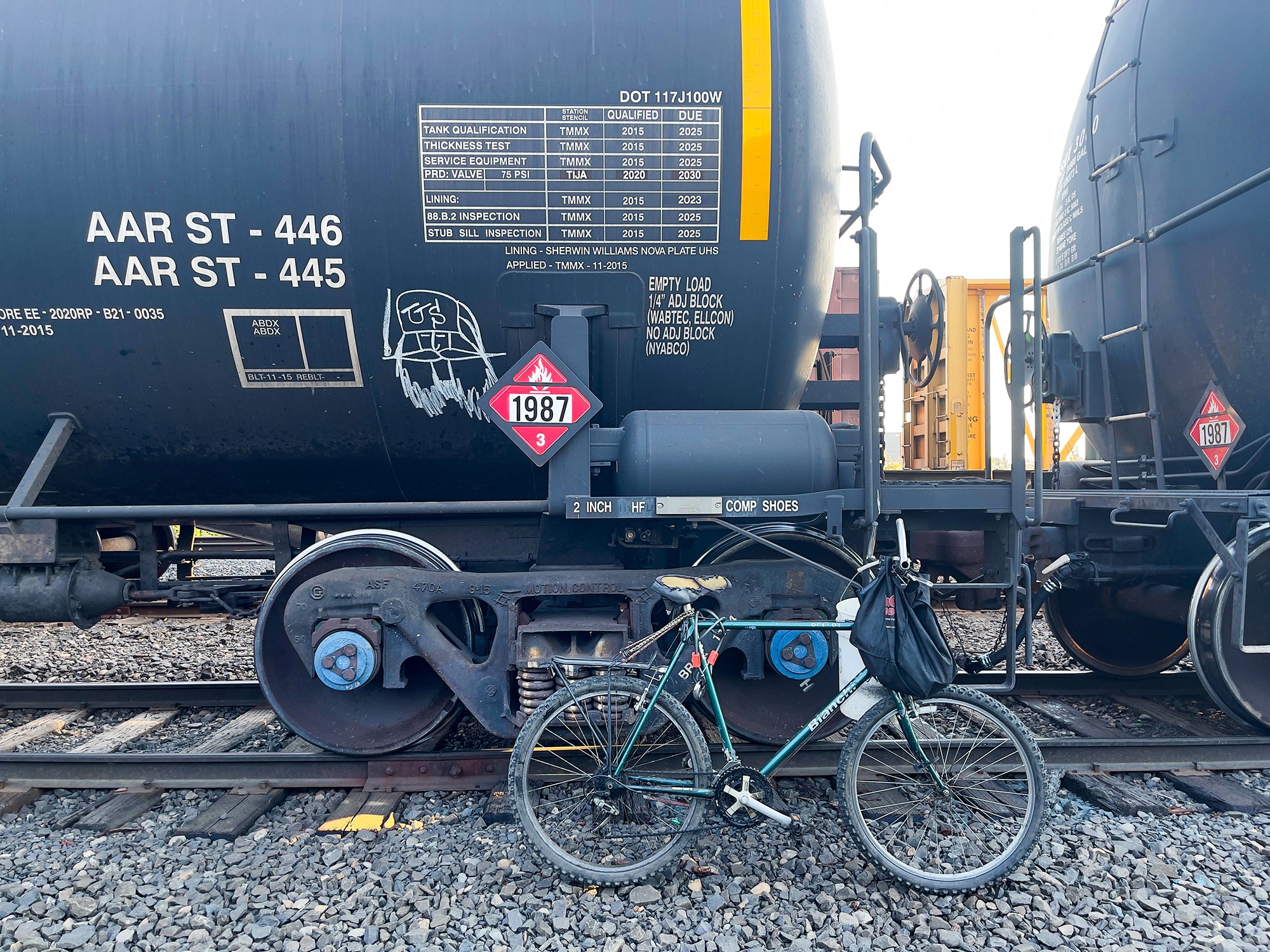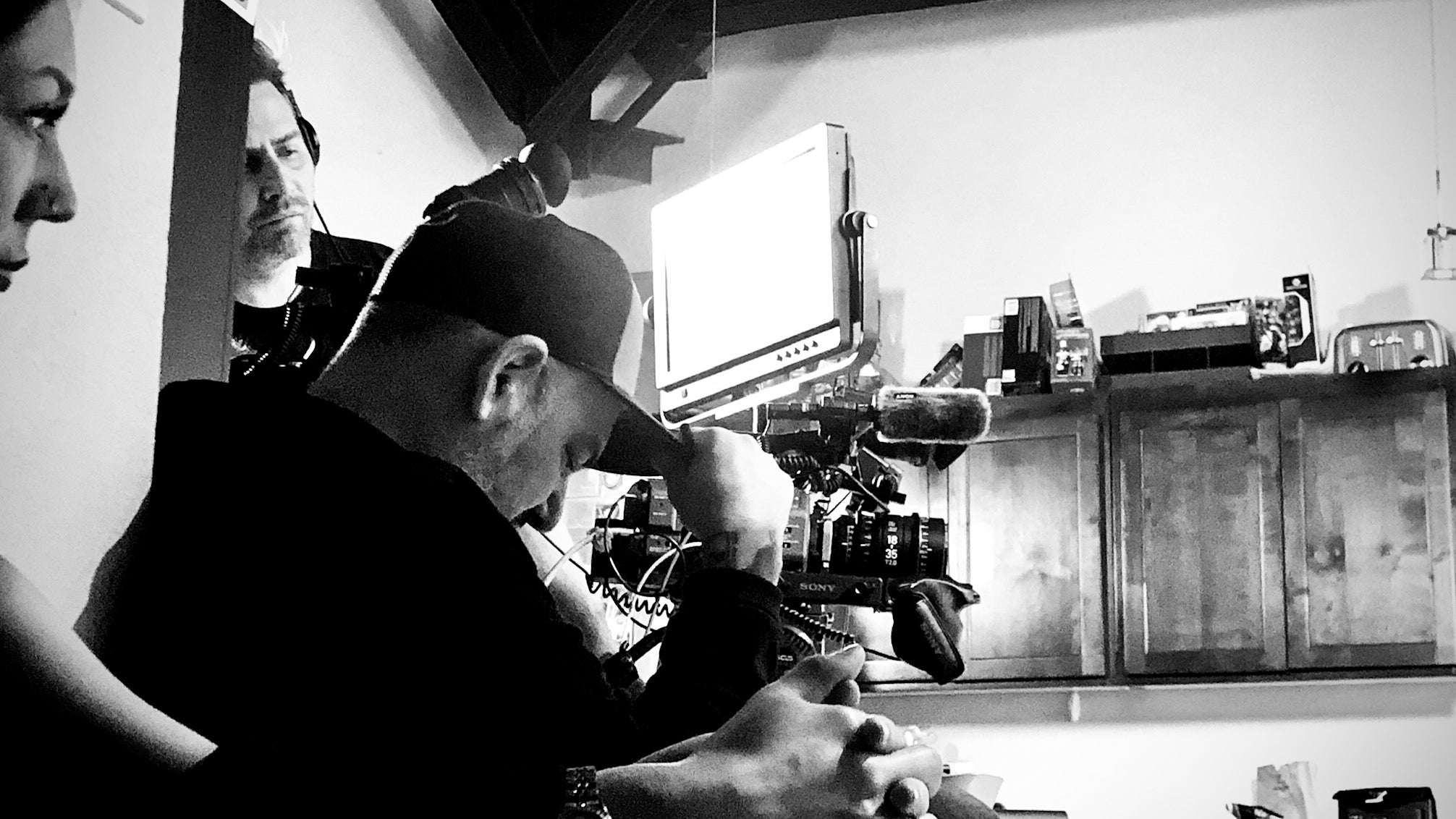
On the heels of the release of Freight Train Graffiti, the expanded version, we catch up with our own Roger Gastman to talk about the pivotal role freight trains played within the graffiti movement, as well as his time directing the Showtime documentary film, Rolling Like Thunder. A maestro of countless creative ventures, Gastman shares why he transitioned from graffiti writer to documentarian and how all those years of goodwill allowed a book like Freight Train Graffiti, and story like Rolling Like Thunder, to come together in such a comprehensive and unfiltered way.


STAFF161, photo by Tim Conlon and AERUB & MERLOT, photo by Mike Schoen
Luis Ruano: I watched the film, and maybe this is coming from someone that hasn't been as immersed in the scene, but I was surprised that some of these folks were so willing to talk on camera and show their faces and stuff. Did that surprise you at all?
Roger Gastman: We have a great relationship with so many of the artists in this culture, and we've done right by them in the past, we've been able to keep their identities hidden and respect them and not put them in compromising positions. The projects we've had have been so authentic and had such great integrity to them, that the artists, thankfully, even the ones that are often very guarded with their identity, wanted to take part in it because they knew that their voice was important, and that they did it for the greater good of the culture to help get the proper story told, and trusted us to respect them with their identity. You look at crazy shows on HBO, the History Channel, and everything else, and you got drug dealers with piles of money and guns talking. So, hidden identities aren't that crazy these days anymore, at least on the TV screen.


ICH, photo by Roger Gastman and DAKS, photo by Roger Gastman
How important do you feel freight trains have been to the story of graffiti? Its definitely its own subculture.
Freight train graffiti is absolutely its own subculture in the graffiti community at this point. It's so massive, you can't look at a freight train going by anywhere in the Americas and not see graffiti on them. It's a rarity. And if you see one without graffiti on it, it's probably brand new and has just been painted. Going into the freight yards now versus the 90s and even the mid 2000s, you can't really find an empty car. It's an important piece of the culture at this point. There's artists dedicated to it, and it's traveling with your name throughout the Americas. It's being watched, it's being paid attention to, it's helping develop styles, and it's continuing to spread the word of graffiti. What other moving surface are you going to get to move your name on around the entire country?
Is there any concern that some of these names and stories are going to start to fade away a little bit as trains get decommissioned, or will it just continue evolving?
The story and the culture just keep continuing evolving. Of course, great photo documentation, video documentation, and anything like that, going back to when this culture really kicked off in the late 80s, is few and far between. And of course, the last 15 years, there's been way better documentation of it than there was before. Now there's documentation of everything that gets done. But like any subculture, being able to tell the story is important, being able to dig into the history is important, and making sure the history is preserved is important. Thankfully, the freight train culture is not super old and we're able to still talk to most of the pioneers that helped kick it off and watched it roll into what it is today.

John Easley, photo by Roger Gastman
What did you learn as a film director that you feel you were able to apply to some of the other creative ventures in your life. Was there something you picked up that surprised you?
Thankfully, because I have a decent relationship with a lot of them, I felt like I could interrupt our subjects in the film a bit and kind of nudge them, in a sense. Not to open up and tell things they wouldn't normally, but just so I could have a little bit more opportunity to be like, "dude, we're not going to use that, stop talking about that, tell me this story." So, I think what I've continued to learn through all of these projects is to do my best to listen to the artists and let them tell their stories and not always assume. Every time I go out and do one of these projects I'm in the field doing so many interviews over and over again, I just constantly have to remind myself to treat so much of what I'm doing with the respect it deserves.
I was never the best or most active graffiti writer, but I was a good graffiti writer and I did a lot of it for years, including painting hundreds and hundreds of freight trains. The artists we talk to know that and respect that, and understand I'm coming from a place of where I've lived through some of those similar experiences they have as writers. The thing I've continued to learn is as much as I want to assume things, and of course, there's certain things I absolutely know and can assume, I know to ask them anyway and let them tell their stories.


AERUB & MERLOT, photo by Tim Conlon and US SCOUT, photo by Tim Conlon
So, when I'm doing a photo shoot, there's a certain point during the process where I feel like I'm hitting my groove from behind the lens. There's a point where I'm thinking to myself, "this is going to come out looking great," and theres a certain energy present. When you're making a film, at what point do you start to feel it coming together, where you're confident and feels its going to be amazing?
For this film, it was so short and expedited to make it, I, in a sense, had written the film in my head ahead of time. I knew it would change five times over by what the subjects were saying, but I am usually an interview or two ahead in my head, when I'm sitting there talking to someone, and all the interviews we've done, thinking, "okay, how is this sentence going to cut with this? I'm going to interview someone in two days, shit, this guy just said something really good, I can get someone in two days to say something about that, then I can cut with this, I need to jump back to this." So, about three to four artists in is when I really know. I knew this was going to be what we wanted it to be because I could start to see those scenes materializing in my head.
So you're building the story out in your head as it's being filmed?
Absolutely. And it's knowing, "oh, who talked about what, and how can you cut that with this?" Because someone could tell you the best story, but you don't want to hear someone talk for four minutes and there's no B roll to go with it. So, what are you going to do in lieu of photos? Well, you need two other people to help tell that story. Are we talking to those people? No. Does anyone know that story? No. Might someone have heard it as a rumor? Sure. So can I ask the next person, "did you ever hear a rumor about blah, blah, blah?" And then cut that with that. Or, "hey, so-and-so that we interviewed, I heard he's crazy, what do you think?" "Oh man, that guy's crazy, I heard one day he did blah, blah, blah." So, it's like, how can you just keep cutting back and forth?
In today's world, people don't want clips of anything that are more than 15 seconds long. So, how can we keep people's attention, and always remember the story we're shooting is much bigger than just a freight train graffiti story? We didn't make a freight train graffiti story, we made a story about people that are artists and that have an obsession. In a sense, you could cut and paste a lot of different obsessions in there, and that's what we would a film about. One way we always have to look at this stuff is that it's not just a story about freight trains. And if it's only a story about freight trains, then you're going to lose your audience.


SUG, photo by FAVES and THE SOLO ARTIST, photo by THE SOLO ARTIST
Speaking of obsessions, Tim Conlon is an artist that's dedicated a big part of his life to freight train graffiti. What was his role in the film?
Yes, he was an executive producer on it and helped with literally every part of it. He is from the DC area, so we've known each other a long time.
Whenever we've shown his art at our large scale shows and made really incredible things that people want and purchase, he's always really upfront, talking about other artists, their influence, wanting to turn other people on. It's never just about him, it's about the greater good of the project. So, it was very important to work on the film with him, as it wouldn't have been the same movie without him. The only bad thing about working with him was he didn't get to be in it. So, other than that, it was a win!
Every project we've worked on together has been fantastic. I knew as soon as I got the phone call to work on this film, that if this film was going to succeed and be everything we wanted it to be, I was going to need to work with a team on it, and I knew Tim was going to be the number one person on that team to help make it be what it needed to be. Thankfully, he got on board and helped make it be what it was, or what it is. I have worked with him many times, with his art, with special projects, with brands, everything, and everyone always leaves wanting to work with him again.
Well he has a show coming up at BEYOND THE STREETS soon! Celebrating a 30-year milestone in freight train graffiti. So, that'll be exciting.
Absolutely. Yeah. Everything with him is always exciting. He gets the job done.


Original Release (2006) and Expanded Edition (2023) Side-by-Side
Can you talk a little bit about FREIGHT TRAIN GRAFFITI the book? It's been almost two decades since its initial release and I'm sure many within the culture will be excited to get their hands on the new expanded edition.
Myself, Darin Rowland and Ian Sattler created this book by going city to city, talking to people, knocking on doors, meeting people in parks, and gaining trust. There were people that let us take a lot of their photos, some which were their only copies (no negatives existed), and trusting us with them. Us taking those photos with us, scanning them and getting them back to them and then doing extensive interviews, them trusting us with their story, and putting the book together--it was a lot of work.
Then in 2006 it came out, and it was great. It told the story that hadn't been told before. A great part of it was it was a living story, that, again, started in the late 80s, but we could look at monikers that go back 100 years, and other odd ends. For the greater part of the story, it starts in the late 80s. So, there were people that we could talk to. The older people we were talking to at that time were in their forties, so it's not like it was that old of people, it was completely realistic in stretch.
For this 2nd edition, we didn't really expand the story. When the original book came out, the freight scene was still very much a subculture. The people that we were talking to, if you'd started painting freights in 2003, we probably weren't talking to you for the book. You were too new. But now, if you look at it, it's nearly 20 years later that this book is coming out, that new people probably started painting and being a part of the culture and the community. When we were working on this book, yeah, people were doing email, but they weren't taking good digital photos, everything was still hard copies, it was a lot scanning, everything was much more private, like phone calls to landlines and things like that.
We always had envisioned it would be bigger and crazier, and of course, the publisher kept making it smaller and smaller. But again, it came out, it did its thing, and it was great. There were tons of bookstores when it came out. Borders, Barnes & Noble, there were all those things. The book's been out of print for a long time, the freight train community and culture has probably had five generations since every couple of years there's new generations of artists. There's been multi-generations of artists that have come since. We've lost several people too that were in the book, that we interviewed. Collections have been lost and people have gone on to do other things, but there's many that still talk to us about the book a lot. People are really excited about this new release as the original isn't easy to find anymore.
So, we decided to put it out again. We've been distributing books ourselves, and just making things ourselves on our own terms, so we're not sitting there waiting for a publisher to give us a page count or this or that. I wanted to do it for a while, I just never got around to it, but we finally dug into it, and while we were working on the freight train movie, it was just a perfect opportunity to work on the book.
I knew we wanted to add to the first edition, but I didn't want do more interviews, I did not want to bring it up to present day, since that's a whole other book. Maybe a whole other two books. I just wanted to make sure that the proper story was told, which we told. No one really gave us any huge things of, like "you fucked up here, you fucked up there." So, we opened up the old files and redesigned, sticking to the guidelines of the original layout, with a much larger format and larger photos. We moved a couple things around and only a few photos are missing in the new one from the old one. These were just files we couldn't locate, that is what it is. But we thought it would be important to add more photos as more stuff has surfaced. So, we went into our archives and we added 500 photos to the book. All photos that were from 2004 or earlier. So, they're all photos that we would've picked or put in the book originally. More photos from some of everybody's favorite writers, and more photos from a lot of writers that we missed that should have been in the book. So, it's great and it's expanded, so even if you have the first one, this is definitely something you need if you like freight train graffiti.
It's interesting that it almost serves as a yearbook. For some of these writers I'm sure it's awesome to dig through the book and find work they maybe thought was lost forever.
It is. Artists definitely use it as a yearbook. They take it around everywhere and get everybody to sign it. It's one of the more special projects I've made.
The 2023 expanded version of FREIGHT TRAIN GRAFFITI is now available through our online store, and in-person at the BEYOND THE STREETS Gallery and Gift Shop in Los Angeles. Rolling Like Thunder is available on most streaming platforms, including Hulu, Paramount+, Apple TV and Prime Video.
Image Below: Roger Gastman & Joseph Pattisall, photo by Mike Schoen

